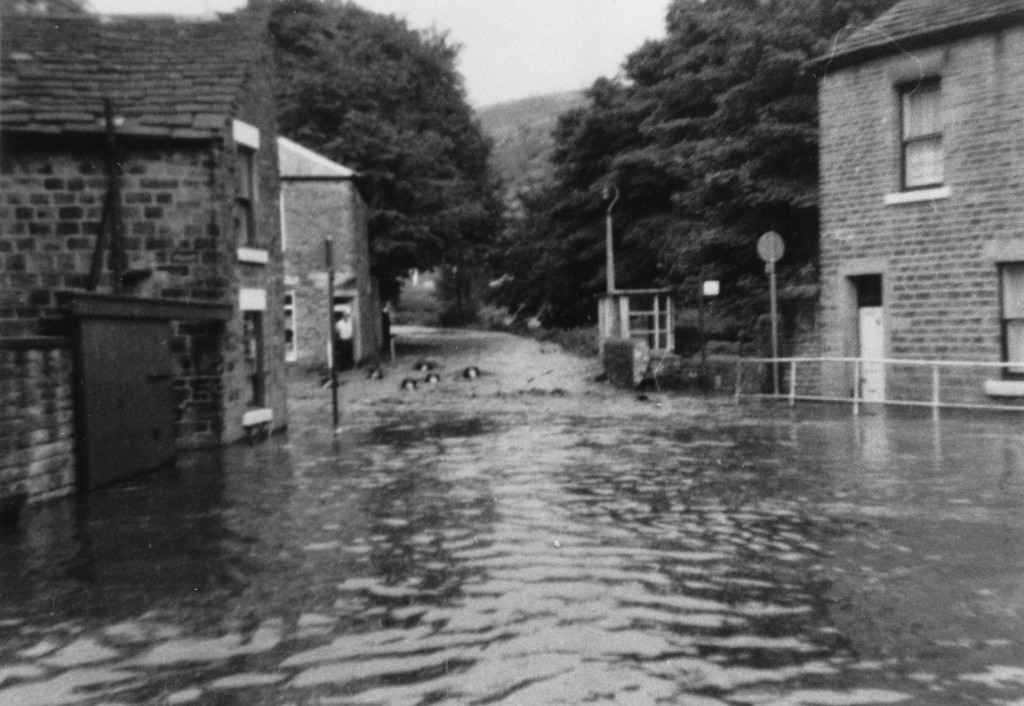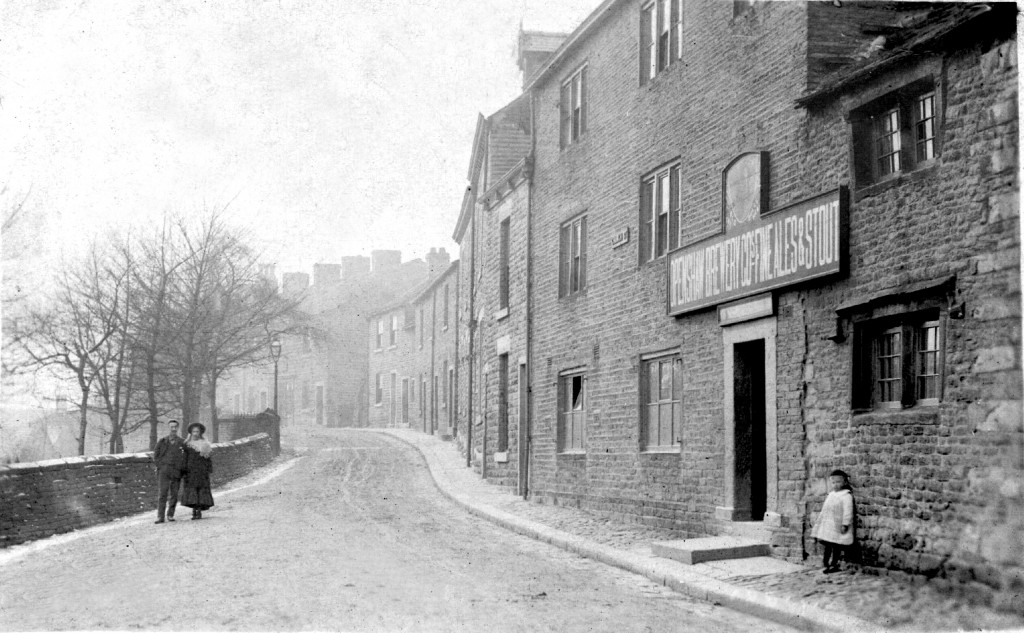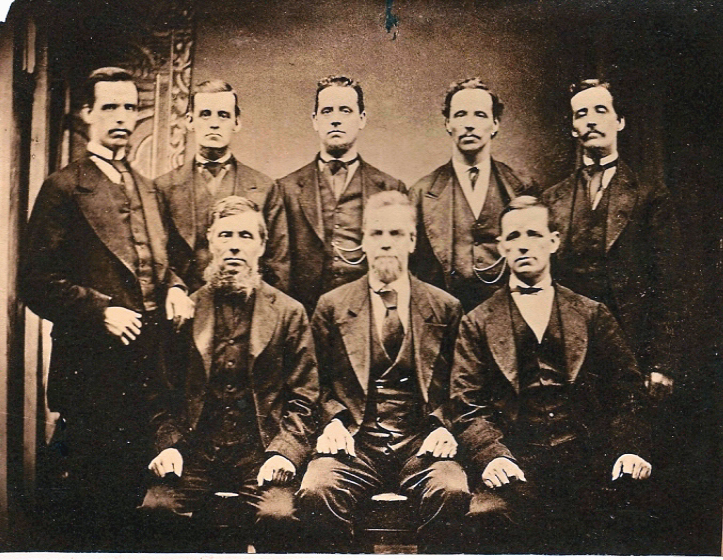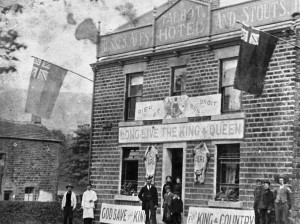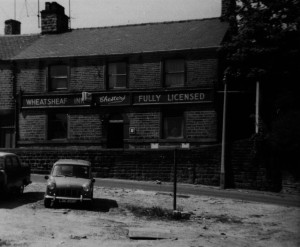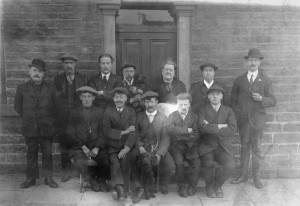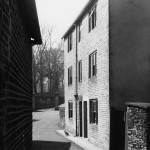At one time there were at least twelve pubs in Old Glossop.
The Queens Arms
The Queens Arms was named in the same year that Queen Victoria ascended to the throne in 1837. When the Marple Bridge to Glossop Turnpike arrived here in the early 19th century a turning area was created in front of it, which probably coincided with a diversion of the brook that originally flowed across this area. The plentiful water has often flooded this area, as the audio trail – available on the downloads page – reveals.
The Glossop Tramway terminated outside the Queens Arms when it ran for 24 years from 1903. It was a single-track line running from Hadfield Station, weaving around a number of mills along its 4½ mile length.
According to the New Mills Local History Society the town’s main administrative building once stood opposite the Queens Arms.
“The Town’s Hall…is a strong well-built stone structure, in which a select vestry meet every other Week, to transact the business of the town; underneath which is a hearse house, with two lockups attached, one for male and the other for female delinquents.”
The Bulls Head
The Bulls Head is thought to be the town’s oldest public house. It was originally a weaver’s house, with a date stone above the back door, now hidden from view, indicating it was built in 1607. It was rebuilt and extended in 1793 and its alehouse status was granted in 1787.
There are a number of opinions regarding the name of the pub. Some people believe that it was named after the bull baiting that traditionally took place during the Wakes. The iron ring used to tether the bulls is said to remain under the road surface just outside the pub. Dogs would attack the tethered bull and the winning dog was the one that held on for the longest.
Other people believe that the name stems from a religious source and that bull comes from papal bull or bulla, an ecclesiastical seal used by papist Rome. When Henry VIII defied the papal bull in 1538, and added a bull’s head to his coat of arms the name became a popular pub name as people wanted to show loyalty to the crown.
The Prizewinning Glossop Handbell ringers used ‘the Bull’ as their HQ.
The Talbot
The 1841 Census return refers to this building as Bridge House. Within 10 years it had became known as the Bridge Inn before taking the name ‘The Talbot’, prior to the 1861 Census.
The name has local historical significance. With the dissolution of the monasteries in the 16th century the Manor of Glossop was passed to the Talbot family. In 1606 Alathea Talbot the daughter of the 7th Earl of Shrewsbury, married Thomas Howard, Earl of Arundel with the Glossop estate part of her dowry. The marriage signified the start of the Howards’ long association with Glossop, and they were to remain Lords of the Manor for the next three centuries. A Talbot was also an extinct breed of dog favoured by packhorse men.
The legendary Wild Weekend celebrations took place on land between the Talbot (image above) and Hare and Hounds, where a row of red brick terraced houses stand today.
The Hare & Hounds
According to the book ‘History in a Pint Pot’, The Hare and Hounds was opened by Joseph Hadfield as an alehouse in 1826. The 1841 Census shows he was still the innkeeper, along with his son Charles and three servants.
Although John and then Thomas Higginbotham (who went to hold the Queens Arms license for 21 years) soon took over as licensees, the inn was back in the hands of the Hadfields by 1848. Charles kept the pub for the following 15 years.
Today the former Hare and Hounds is two separate private houses.
Rita Manzies grew up in the Talbot after it was a pub.
“…that used to be a public house, didn’t it, the house that me mum and dad bought. But we had a ring in our kitchen before me mum and dad had it alterered and what not; a big ring where cattle were tied up to.
Wheatsheaf
The Wheatsheaf dates to at least 1824 but was only used as an alehouse from 1860. At that time it was called the ‘New Inn’. Our Old Glossop timeline panel stands opposite this building.
The Greyhound
One of the buildings in Hope Street was a pub called the Greyhound, built about 1829. It was known locally as ‘The Small Dog’ and the local Trail Hound supporters met here when it was a popular local sport. Hope Street was known locally as Roughtown.
Ring o’ Bells
Numbers 22 and 22A Old Cross (Grade II) are former weavers cottages dating from the early to mid 18th century. They differ from the majority of buildings in that they are 3 storeys in height. During the second half of the 19th century these two houses were a beerhouse called the Ring o’ Bells.


